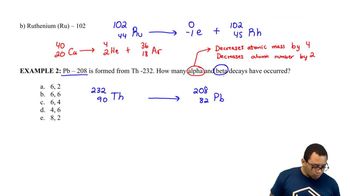Identify each of the following as alpha decay, beta decay, positron emission, or gamma emission:
b. 9038Sr → 9039Y + 0–1e
 Verified step by step guidance
Verified step by step guidance Verified video answer for a similar problem:
Verified video answer for a similar problem:



 2:06m
2:06mMaster Types of Radiation Concept 1 with a bite sized video explanation from Jules
Start learning